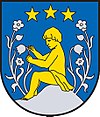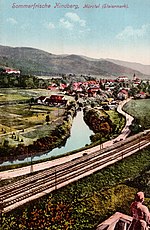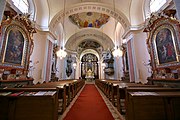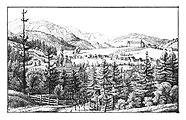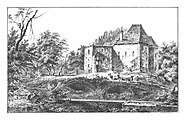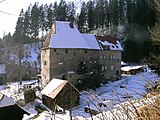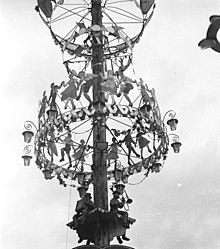Kindberg
|
Borough Kindberg
|
||
|---|---|---|
| coat of arms | Austria map | |
|
|
||
| Basic data | ||
| Country: | Austria | |
| State : | Styria | |
| Political District : | Bruck-Mürzzuschlag | |
| License plate : | BM (from 1.7.2013; old: MZ) | |
| Surface: | 90.52 km² | |
| Coordinates : | 47 ° 30 ' N , 15 ° 27' E | |
| Height : | 565 m above sea level A. | |
| Residents : | 8,150 (January 1, 2020) | |
| Postcodes : | 8643, 8644, 8650, 8652, 8653 | |
| Area code : | +43 3865 | |
| Community code : | 6 21 41 | |
| NUTS region | AT223 | |
| UN / LOCODE | AT KIN | |
| Address of the municipal administration: |
Hauptstrasse 44 8650 Kindberg |
|
| Website: | ||
| politics | ||
| Mayor : | Christian Sander ( SPÖ ) | |
|
Municipal Council : (2020) (25 members) |
||
| Location of Kindberg in the Bruck-Mürzzuschlag district | ||
| Source: Municipal data from Statistics Austria | ||
Kindberg is a city with 8150 inhabitants (as of January 1, 2020) in the Austrian state of Styria ( Mürzzuschlag judicial district in the political district of Bruck-Mürzzuschlag ).
geography
Geographical location
Kindberg is located in the Mürz Valley about 17 km northeast of the district capital Bruck an der Mur and about 20 km southwest of Mürzzuschlag . In the south are the Fischbacher Alps and in the north the Mürz Valley Alps , a wooded low mountain range at the southern foot of the north alpine high mountains with the Aflenzer Staritzen and the Veitschalpe.
Community structure
The municipality includes eight localities (residents as of January 1, 2020):
- All Saints' Day in Mürz Valley (267)
- Edelsdorf (364)
- Jasnitz (212)
- Kindberg (5290)
- Leopersdorf (465)
- Mürzhofen (951)
- Solsnitz (117)
- Wieden (484)
The community consists of eleven cadastral communities (area 2016):
- All Saints' Day (213.12 ha)
- Edelsdorf (1,047.96 ha)
- Herzogberg (1,032.00 ha)
- Jaßnitz Valley (2,532.26 ha)
- Kindberg (359.06 ha)
- Kindbergdörfl (1,019.93 ha)
- Kindtal (326.66 ha)
- Kindtalgraben (1,417.31 ha)
- Mürzhofen (192.88 ha)
- Sölsnitz (925.05 ha)
Incorporations
As part of the municipal structural reform in Styria , Kindberg was merged with the municipalities of Allerheiligen im Mürzhofen and Mürzhofen in 2015 .
Neighboring communities
All neighboring communities are in the Bruck-Mürzzuschlag district.
| Turnau | Sankt Barbara in Mürz Valley |
Sankt Barbara in Mürz Valley |
| Sankt Lorenzen in Mürz Valley |

|
|
| Sankt Marein in the Mürz Valley | Breitenau am Hochlantsch | Stanz im Mürz Valley |
history
The area around Kindberg was only sparsely populated under the Celts, Romans and Slavs. In the 8th century the first Bavarian settlers settled in the Mürz Valley. More intensive settlement and clearing took place in the 12th century. The first documented mention of Kindberg around 1172 "Chindeberch"; Iron trade since the 14th century, scythe production from the 18th century.
On May 8, 1267, one of the worst earthquakes in Austrian history occurred near Kindberg . The earthquake is estimated to be 5.4 on the Richter scale .
Favored by the traffic on the "Venedigerstrasse" over the Semmering to Vienna, the market was raised in 1281 by Rudolf von Habsburg . Since 1982 Kindberg owns the city charter .
The hunt for a predator in the Burgerwald near Kindberg caused a sensation in 1921, where a 40-man battalion party came on April 23, 1921, and a large wolf was shot shortly afterwards. The sensation was not least due to the fact that the memory of another predatory wolf, the peasant fright from the Koralm, was still alive.
Population development

Culture and sights
buildings
- Gothic parish church (1773/74), redesigned in Baroque style; Wall paintings 1948; surrounded by the remains of a medieval defensive wall
- Calvary with church (1674–1686); Gothic-baroque church of St. George
- Baroque castle Oberkindberg (before 1680, remodeling in 1773/74, from 1980 onwards at times mining and local history museum), stucco ceilings
- Hart Castle (1523)
- Kindtal Trade Palace (18th century)
Site design
Kindberg's landmark is the Kindberger Zunftbaum , a 30 m high tree on the main square. It goes back to a maypole that was set up seasonally during the war years under the long-time tourism chairman Franz Gruber. Based on the example of the ornate tree in Schliersee (Bavaria), Gruber had a guild tree designed by Anton Babion . First the guild signs were attached to the side strips, then the most important professions were represented figuratively. The ten guilds were supplemented with a Mürzaler dance couple and musicians, a stagecoach and a wedding couple as well as the coats of arms of the nine federal states and, most recently, the Kindberger Kindl. The guild tree is renewed every five to ten years. There are three sets of figures.
As part of the European “ Entente Florale Europe ” competition, Kindberg was awarded a gold medal in 2003 and a silver medal in the city category in 1997 .
At the state flower decoration competition Flora | 19, Kindberg was one of the 7 Styrian cities and received a total of 5 Floras, making it one of the state's winners.
Economy and Infrastructure
At the end of the 19th century tourism became very important for the region. Kindberg became a well-known place for summer vacation.
The iron industry, which for a long time shaped the townscape of Kindberg and the region, developed from a hammer mill in Aumühl, which today belongs to VOEST-ALPINE AG . In order to compensate for the economic problems in the iron industry at the end of the 20th century, efforts were made to locate more companies in the electronic industry.
traffic
Kindberg is located on the Semmering expressway S 6 and on the southern railway , which form the transport connection to the economic area in Lower Austria and Vienna in the northeast and to Italy and Slovenia in the south.
Kindberg train station is located on the Südbahn . Numerous regional trains stop in the direction of Bruck an der Mur or Mürzzuschlag . But trains often run to Leoben , Friesach , Neumarkt , Unzmarkt , Graz and Spielfeld-Straß .
Established businesses
- Voestalpine Tubulars, a company of VOEST-ALPINE AG , which has been producing seamless steel tubes since the official opening on September 28, 1981 after a trial run from April 1981 .
education
In the original town of Kindberg there have been various schools over the years, and over time these have been relocated to new locations or have been split up or even merged.
Elementary schools
In the 1990s there were two elementary schools in the same building, which were merged into one elementary school in the 2000s. The names of the two elementary schools at that time were Elementary School I and Elementary School II . The current school building was built in the 1970s, with the then Federal President Rudolf Kirchschläger , among others, represented at the opening on November 20, 1976 . Over the years there have been various renovations and an expansion of the green areas.
With the structural reform of the Styrian community in 2015, in which Kindberg was merged with the communities of Allerheiligen in Mürz Valley and Mürzhofen , the elementary school located in Allerheiligen was added to the educational system of the new town of Kindberg.
Hauptschulen or new middle schools
At the urging of the population was back in 1920 for the first time at the then state government Rintelen I to permit a secondary school , at that time public school called applied for. At that time there were only two so-called citizen schools in the entire Mürz Valley , one in Mürzzuschlag and another in Kapfenberg . Since the community school was considered an elective school and only a few parents in rural areas could afford to send their children to such schools, it took a few more years before the plan to build it became concrete. After the first plans for a secondary school building were already in place in 1928, due to the prevailing poor economic situation, it took many years again before the construction of an eight-grade secondary school was approved on June 2, 1942. The hammer mill in Aumühl played a large part in this, and its urgent request led to a review of the situation and, accordingly, to approval. Due to the turmoil of the Second World War , which was ruling at that time, a new school had to be refrained from building for the time being, although the community undertook to provide the necessary classroom. This was also found in a class made available by the boys' elementary school. Thus, on September 6, 1943, the first 40 students from the communities of Kindberg, Allerheiligen, Mürzhofen and Stanz attended the first lesson in the secondary school. The lessons were held by the teacher Josefine Ritter. The head of the boys' elementary school, senior teacher Alfred Frischenschlager, was entrusted as the provisional director. After there were already two classes in the autumn of 1944, the primary school building was cleared shortly afterwards due to the approaching war to make room for refugees. If necessary, teaching was continued with classes in what was then the “Cafe Wien”; but when the Russians had come very close, all schools in the Mürz Valley were closed.
Shortly before the official end of the Second World War, classes were resumed on June 1, 1945. From this time on, Irma Kahr was in charge of the school. Since many of the students were malnourished, they were supported by school meals and Swiss food parcels. In the school year 1946/47 the school had to be closed for a month due to a lack of fuel; in the same school year the first 40 graduates left the school. Due to a polio epidemic , teaching at all Styrian secondary schools did not begin until October 1947. After the previous director Irma Kahr retired, on October 1, 1947 Johann Leisch took over the vacated post of headmaster. After the region had financially recovered from World War II, took place on 21 April 1949 by the then district captain Alfred Schachner-Blazizek the groundbreaking ceremony for the new building of secondary school. After almost two years of construction, the secondary school with eight classes was officially opened on February 10, 1951 in the presence of numerous representatives from public life. In the following two years the school was completed with a kitchen and a gym (both in 1952), as well as a teacher's house and the sports field (both in 1953). In 1953 the school had twelve classes; four years later the first school ski course took place on the Brunnalm in the municipality of Veitsch . After the villages of Allerheiligen, Stanz and Kindbergdörfl were badly affected by a devastating storm in the following year, the pioneers from the Klosterneuburg pioneer barracks and pioneer troop school were housed in the secondary school.
In 1963, the then Federal President Adolf Schärf was a guest in Kindberg. With the start of school in 1966/67, the polytechnic course with three classes was introduced for the first time at the Kindberg secondary school . The contract teacher Anton Falzberger was responsible for this. On June 5, 1967, work began on an extension to the school, which was completed a little over a year later. From the following school year 1967/68, the students from the Mürzhofen community no longer belonged to the Kindberger school district, but came to the secondary school in St. Marein. In the same school year Josefine Ritter, who had done pioneering work in the secondary school, also retired. On October 19, 1968, the opening of the new extension, which created eight additional classes, took place. Since the music-pedagogical secondary school in Kindberg was opened in the following school year , three classrooms and two adjoining rooms had to be given to it in the annex. With 616 students who were taught in 20 classes, the Hauptschule also reached its highest level this year.
Due to the large number of pupils and related organizational reasons, the Kindberg secondary school was divided into two schools at the beginning of the 1970/71 school year, following an application from the market town of Kindberg. From then on there was a secondary school for boys on the lower floor under the direction of the previous director, OSR Dir. Johann Leisch, and the secondary school for girls on the upper floor with HOL Franz Seidl as the provisional director. As a result of the school space shortage and the further increase in the number of pupils, with 401 pupils in 14 classes attending the boys 'main school and 443 pupils in 15 classes attending the girls' main school, classes for afternoon classes and so-called hiking classes were introduced in 1973/74 . After he had previously only acted as a provisional director, Franz Seidl was finally appointed director of the girls' secondary school that school year. Since the secondary school in Mitterdorf opened in the following school year 1974/75, the number of pupils decreased somewhat, as pupils from Wartberg now mostly attended the new school in Mitterdorf. The 1976/77 school year also brought new changes, when a parents' association was founded for both Kindberg secondary schools and shortly afterwards the renovated school kitchen was ceremoniously handed over to its destination. On September 1, 1978, Johann Leisch retired after more than 30 years as school director, after which Helge Haller was entrusted with the management of the boys' main school.
Under the new leadership there was a major change from the 1980/81 school year. Due to a unanimous decision, the boys ' main school was renamed August Musger main school and the girls' main school Jakob-Eduard-Schmölzer main school . From the following school year, both schools were mixed from 1st to 4th grade, after which there were no longer any boys or girls classes. In 1982, when the Kindberg market, which had existed for 750 years, was elevated to the status of town, the Styrian pupil league final also took place here, in which the two schools were responsible for the supporting program. In the 1982/83 school year, a central student library was set up for both secondary schools. In 1984/85, the parents' association received the Kinderfreunde Oscar, a special and prestigious award.
At the beginning of the 1985/86 school year, the main school, which had previously been run in two classes, was replaced by the new main school with ability groups in German, English and mathematics. After OSR Helge Haller retired on January 31, 1988, Friedrich Zotter took over the management of the August-Musger-HS. Only two years later, the head of the Jakob-Eduard-Schmölzer-HS, Franz Seidl, retired after almost 20 years and handed over his office to the former professional footballer, current teacher and later mayor of the city, Karl Hofmeister . Shortly beforehand, in the 1988/89 school year, the general renovation of the building began and the physics room was rebuilt for both schools. In the 1989/90 school year, the multi-award winning project “Schoolchildren learn to understand the forest”, which had run over four years, came to a preliminary conclusion, which was reported today in Styria , among others . In order to enable more modern teaching, both Kindberg secondary schools were equipped with computer systems in the school year 1990/91. In the same school year, the national volleyball school league took place in Kindberg , with both schools again being responsible for the supporting program.
In the school year 1991/92, when there was another change in the learning system and the 1st grades were no longer taught in performance groups, but in so-called team teaching by two teachers in the subjects German, English and mathematics at the same time. In that year the general renovation, the cost of which was put at 20 million schillings , was completed. In the following school year there was a further change in the learning system, according to which in the school experiment "internal differentiation" the pupils were only classified in performance groups after the 2nd grade. After HDir on March 1, 1997. When OSR Friedrich Zotter retired, Gottfried Doppelreiter was first appointed provisional director, before he was replaced on March 1, 1998 by Mag. Karl Pichler as director of the August Musger secondary school. After 1982 the Styrian school league final took place again in 1999 in Kindberg . In the 1999/2000 school year, the teacher Sieglinde Rossegger was awarded the Pedagogical Panther , the highest award for schools and people involved in education in the state of Styria. At the end of the 2000/01 school year and in the subsequent holidays, the gymnasium used by both schools was renovated. In addition, a new computer room was set up, the devices of which were connected to the Internet by cable and which was equipped with a data projector.
When Karl Hofmeister retired in 2009 and resigned his office as mayor, which had been in effect since 1993, his colleague Klaus Kolednik followed him as head of the Jakob-Eduard-Schölzer-Hauptschule. With the 2015/16 school year, all secondary schools across Austria were converted into new secondary schools (NMS) in a step-by-step plan ; the two secondary schools in the city of Kindberg already had the 1st grade as an NMS class at the beginning of the 2013/14 school year. Both schools now appear as NMS-Jakob-Eduard-Schmölzer and NMS-August-Musger , but are still in the same building complex. In June 2016, the three-year general renovation of the new middle school, which cost 5.4 million euros, was completed. The painter Günter R. Sander , who comes from Kindberg and lives in Vico Morcote , Switzerland , and the uncle of the incumbent mayor Christian Sander, gave the school a painting entitled From Pythagoras to Newton to Einstein , which can be seen in the school auditorium. The painting was then printed on canvas and attached to the school's facade.
Federal upper level secondary school
The Bundesoberstufenrealgymnasium (BORG for short) offers the Matura on site.
Tourism association
Together with Stanz im Mürz Valley, the community forms the “Kindberg- Mürz Valley Orchard Region ” tourism association . Its seat is in Kindberg.
politics
The city council of the municipality of Kindberg is composed of:
- Mayor Christian Sander (SPÖ)
- 1st Vice Mayor Christine Seitinger (SPÖ)
- 2nd Vice Mayor Peter Sattler (ÖVP)
- Financial advisor Judith Doppelreiter (SPÖ)
- City Councilor Eva Hechtner (FPÖ)
The municipal council consists of 25 members and has been composed of mandataries from the following parties since the 2020 municipal council election:
Town twinning
-
 Roßdorf (near Darmstadt) , Germany
Roßdorf (near Darmstadt) , Germany -
 Vösendorf , Lower Austria
Vösendorf , Lower Austria
coat of arms
- Coats of arms of the previous municipalities
All three predecessor communities each had a community coat of arms. Due to the amalgamation of municipalities, these lost their official validity on January 1st, 2015. The new award of the municipal coat of arms for the merged municipality took place with effect from January 1, 2018.
The blazon reads:
- "In a blue shield, a naked child, sitting on a silver mountain, clad only in a loincloth, playing under three semicircularly arranged golden five-pointed stars with one of the silver flowers growing out of the mountain in front and back."
The coat of arms goes back to a legend that says that a child who was swept away by a flood washed up completely unscathed in Kindberg. It was found there sitting in a meadow and playing with a flower.
sons and daughters of the town
- Anton Maier (1876–1955), CS politician , member of the Constituent National Assembly 1919–1920, member of the National Council 1920–1927, Mayor of Sankt Radegund near Graz 1946–1950
- Anton Weber (* 1878 in Kindberg; † 1950), Viennese politician
- Johann Oberhammer (* 1879 in Kindberg; † 1956), Upper Austrian politician and Viennese bank director
- Anton Pirchegger (* 1885 in Leopersdorf; † 1949), Governor of Styria 1945–1948
- Peter Graf (* 1886 in Kindbergdörfl; † 1977), Mayor of Klagenfurt from 1952 to 1957
- Walter Pelikan (* 1901 in Kindberg; † 1971 in Stuttgart), civil engineer
- Erich Hechtner (* 1958), Municipal Director of the City of Vienna since 2010
- Dieter Rauter (* 1969), Austrian - American stuntman and filmmaker
- Franz Almer (* 1970 in Mürzhofen), former soccer goalkeeper - GAK , DSV Leoben - and now soccer coach
literature
- Rudolf Schlaipfer: The Aumühl. History and stories of an Upper Styrian industrial location and its population . Self-published, Kindberg 1991.
- Karl Schöberl, Gerhard Schuller: Kindberg 1232–1982. From the old market to the young city . Stadtgemeinde Kindberg, Kindberg 1982, (Part A: Kindberg in a historical exhibition by Karl Schöberl; Part B: The cultural and club life in Kindberg).
- Karl Schöberl: Kindberg. From the beginning until 1918 . Self-published, Kindberg 2008.
- Gerhard Schuller (ed.): Kindberg. 1982017. Pictures of our city. Kindberg 2017.
Web links
- 62141 - Kindberg. Community data, Statistics Austria .
- www.kindberg.at Website of the city of Kindberg
Individual evidence
- ↑ Statistics Austria: Population on January 1st, 2020 by locality (area status on January 1st, 2020) , ( CSV )
- ↑ Federal Office for Metrology and Surveying, Regional Information, reference date December 31, 2016, accessed on February 19, 2017
- ^ Styrian municipal structural reform .
- ↑ Sonja Burger, Martin Kugler: Hidden Signs for Earthquakes. In: Universum Magazin. Krems-Wien 2016. Issue 11/2016. ZDB ID 2092993-6 . P. 59.
- ↑ Robert Price : The great wolf hunt. A hunt as a major tourist event. In: 111 gruesome places in Styria that you have to see. Verlag emons :, Graz 2018. ISBN 978-3-7408-0445-9 . P. 26.
- ↑ The Kindberger guild tree. Stadtgemeinde Kindberg, accessed on August 1, 2017 .
- ↑ FLOWER OFFICE AUSTRIA
- ↑ Flower decoration competition "Die Flora"
- ↑ VOEST-Rohrwerk Kindberg opened . In: Arbeiter-Zeitung . Vienna September 29, 1981, p. 06 ( berufer-zeitung.at - the open online archive - digitized).
- ^ List of speeches by Federal President Dr. Kirchschläger 1974–1986 (pdf), accessed October 20, 2016
- ^ "The NMS in a new guise" , accessed on October 20, 2016
- ^ Grazer Zeitung , Official Gazette for Styria. December 30, 2014, 210th year, 52nd piece. No. 308. ZDB -ID 1291268-2 p. 626.
- ↑ 113. Announcement of the Styrian state government of December 21, 2017 on the granting of the right to use a municipal coat of arms to the municipality of Kindberg (political district of Bruck-Mürzzuschlag) , accessed on December 27, 2017
- ^ [1] The Spiegel report from October 12, 2009
